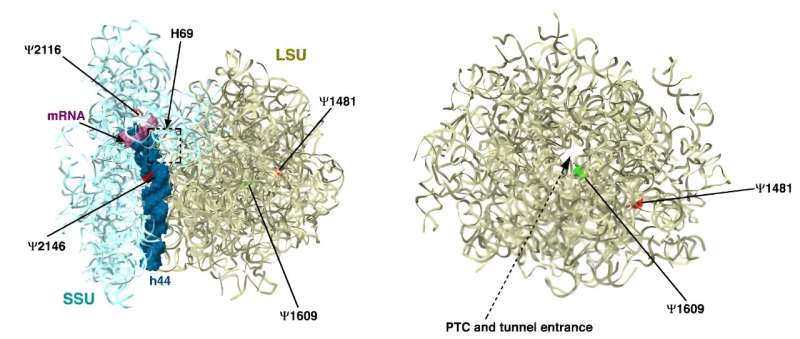This article has been reviewed according to Science X's editorial process and policies. Editors have highlighted the following attributes while ensuring the content's credibility:
fact-checked
peer-reviewed publication
trusted source
proofread
Scientists discover novel way to attack the trypanosome parasite through its ribosome

Trypanosome is a single-celled parasite that takes an extensive human and economic toll due to its involvement in causing sleeping sickness in humans and a similar disease in cattle. The parasite, found mainly in rural areas of Africa, is transmitted to humans or cattle by the tsetse fly. There is no vaccine for the disease, and current treatments are difficult and ineffective due to the resistance of the parasites to existing drugs.
Advanced research by Prof. Shulamit Michaeli from the Goodman Faculty of Life Sciences at Bar-Ilan University, recently published in the journal Nature Communications, offers a new strategy for combating the disease. The research was conducted in collaboration with scientists from the group of Nobel Prize laureate Prof. Ada Yonath, of the Weizmann Institute of Science, an expert on the spatial structure of the ribosome.
The new approach is based on damaging the ribosome of the trypanosome. The ribosome functions in all living cells as a factory for the production of proteins and it is comprised of very long chains of RNA and many diverse proteins. Damaging production of the proteins in the parasite causes a delay in its growth and thus its death.
In the RNA of the parasite's ribosome there are dozens of chemical changes (modifications) that are created by small RNA molecules found in the area of the cell nucleus where ribosomes are produced. One of these modifications, known as pseudouridine, stabilizes RNA molecules, including the ribosomal RNA.
That is, in the absence of even a single specific pseudouridine, the parasite cannot multiply and cause the disease in a person or animal infected with it. Interestingly, pseudouridine plays a central role in the composition of the artificially coded RNA that the coronavirus vaccine contains.
The researchers in Prof. Michaeli's group showed that the deletion of just one pseudouridine from the ribosome of the parasite causes the loss of a structural protein in the ribosome, thereby impairing its ability to produce several specific proteins as well as inhibiting its growth.
The findings of the study show that in the future it will be possible to design RNA-based drugs that will specifically damage the ribosome of the parasite (and not that of the human or cattle host) and thus stop its growth and the development of the disease. The future drug will be aimed at damaging the specific site on the ribosome where the essential pseudouridine is located.
Another innovation in the research is related to the role of pseudouridine in dealing with the very different growth temperature between the two hosts: the tsetse fly, whose body temperature is 26°C, and the human host, whose body temperature is 37°C. Chemical modifications stabilize the ribosome at elevated temperatures and give it the ability to function at a difference of 11°C during the transmission from fly to human.
The set of modifications changes during transmission, and this is what allows the parasite's ribosome to function in the two different hosts. Damage to these modifications negates the ability of the parasite's ribosome to survive the heat differences between the tsetse fly and the human body.
Deletion of the pseudouridine deprives the parasite of both its ability to develop and its ability to survive the transmission from the body of a fly to the body of a mammal. These findings form the basis for the development of a drug that can solve the difficult medical problems caused by the trypanosome parasite and parasites of the same family, such as the Leishmania parasite that causes the Rose of Jericho disease, which has also appeared in Israel.
"This development is exciting because it connects the role of a single modification to the ribosome structure and its function in producing new proteins" says Prof. Michaeli.
More information: K. Shanmugha Rajan et al, A single pseudouridine on rRNA regulates ribosome structure and function in the mammalian parasite Trypanosoma brucei, Nature Communications (2023). DOI: 10.1038/s41467-023-43263-6
Journal information: Nature Communications
Provided by Bar-Ilan University




















